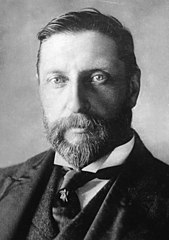Henry Rider Haggard
 | |
| Data i miejsce urodzenia | 22 czerwca 1856 Bradenham |
|---|---|
| Data i miejsce śmierci | 14 maja 1925 Londyn |
| Narodowość | angielska |
| Język | angielski |
| Dziedzina sztuki | literatura |
| Epoka | wiktoriańska |
| Ważne dzieła | |
 | |
| Odznaczenia | |
| Strona internetowa | |
Henry Rider Haggard (ur. 22 czerwca 1856 w Bradenham, zm. 14 maja 1925 w Londynie) – brytyjski pisarz, autor powieści przygodowych z akcją rozgrywającą się w egzotycznych miejscach, najczęściej w Afryce.
Życiorys
Jako młody człowiek przebywał w Natalu i Transwalu (obecnie w Południowej Afryce), pracując w administracji kolonialnej. Haggarda zainspirowały spotkania z eksploratorami Afryki, odkryte tam bogactwa mineralne i ruiny starożytnych zaginionych cywilizacji, takie jak Wielkie Zimbabwe. Powrócił do Anglii w 1882. Zamierzał zostać prawnikiem, ale pochłonęło go pisarstwo. W 1885 ukazały się Kopalnie króla Salomona – pierwsza powieść cyklu o Allanie Quatermainie (łącznie 18 tytułów), którą sfilmowano kilkakrotnie (ostatnio w 2004). Inne głośne i popularne jego utwory z fabułą osadzoną w Afryce to Allan Quatermain, She (Ona) oraz Ayesha. Wśród bardziej znanych w jego twórczości są też Córka Montezumy i powieść sensacyjno-historyczna Kleopatra.
Od 1889 przyjaźnił się z Rudyardem Kiplingiem[1].
W Polsce pisarz był już popularny za życia i w okresie międzywojennym; ponowne ożywienie poczytności jego książek nastąpiło na początku lat 90. XX wieku. W 1951 wszystkie jego utwory zostały wycofane z polskich bibliotek i objęte cenzurą[2].
Oprócz wyżej wymienionych, do poczytniejszych i częściej wznawianych u nas jego powieści należą:
- Córka mądrości (Wisdom′s Daughter)
- Dziecię z kości słoniowej (The Ivory Child)
- Pierścień królowej Saby (Queen Sheba′s Ring)
- Potwór Heu-Heu (Heu-Heu, or the Monster)
- Święty kwiat (Allan and the Holy Flower)
- Zemsta Maiwy (Maiwa′s Revenge)
Przypisy
Zobacz też
- ISNI: 0000 0001 2120 0624
- VIAF: 9841446
- LCCN: n80010495
- GND: 11870057X
- NDL: 00442146
- LIBRIS: tr578ctc1vxk9j6
- BnF: 118864973
- SUDOC: 026658194
- SBN: CFIV012514
- NLA: 36514621
- NKC: jn19990003067
- BNE: XX1721371
- NTA: 068327862, 163371369
- BIBSYS: 90089475
- CiNii: DA03287387
- Open Library: OL23326A
- PLWABN: 9810533718105606
- NUKAT: n93120747
- OBIN: 33632
- J9U: 987007262255205171
- PTBNP: 25323
- CANTIC: a10908134
- LNB: 000002621
- NSK: 000049859
- CONOR: 18196067
- ΕΒΕ: 61968
- BLBNB: 000172694
- KRNLK: KAC199611208
- LIH: LNB:V*73934;=BM
- WorldCat: lccn-n80010495
Media użyte na tej stronie
Illustration from H. Rider Haggard's Maiwa's Revenge, Chapter VII, by Thure de Thulstrup.
The scene shows Allan Quatermain ordering the men to fire, after getting them to wait until the most opportune moment:
| “ | "Now they are going to begin," I thought to myself, and I was not far wrong, for in another minute the body of men divided into three companies, each about five hundred strong, and, heralded by a running fire, charged at us on three sides. Our men were now all well under cover, and the fire did us no harm. I mounted on a rock, so as to command a view of as much of the koppie and plain as possible, and yelled to our men to reserve their fire till I gave the word, and then to shoot low, and load as quickly as possible. I knew that, like all natives, they were sure to be execrable shots, and that they were armed with weapons made out of old gas-pipes, so the only chance of doing execution was to let the enemy get right on to us.
On they came with a rush. They were within eighty yards now, and as they drew near the point of attack, I observed that they closed their ranks, which was so much the better for us. "Shall we not fire, my father?" sung out the captain. "No—confound you!" I answered. "Sixty yards — fifty — forty — thirty. Fire, you scoundrels!" I yelled, setting the example by letting off both barrels of my elephant gun into the thickest part of the company opposite to me. |
” |
Baretka Orderu Imperium Brytyjskiego (cywilnego; 1917-1935).





